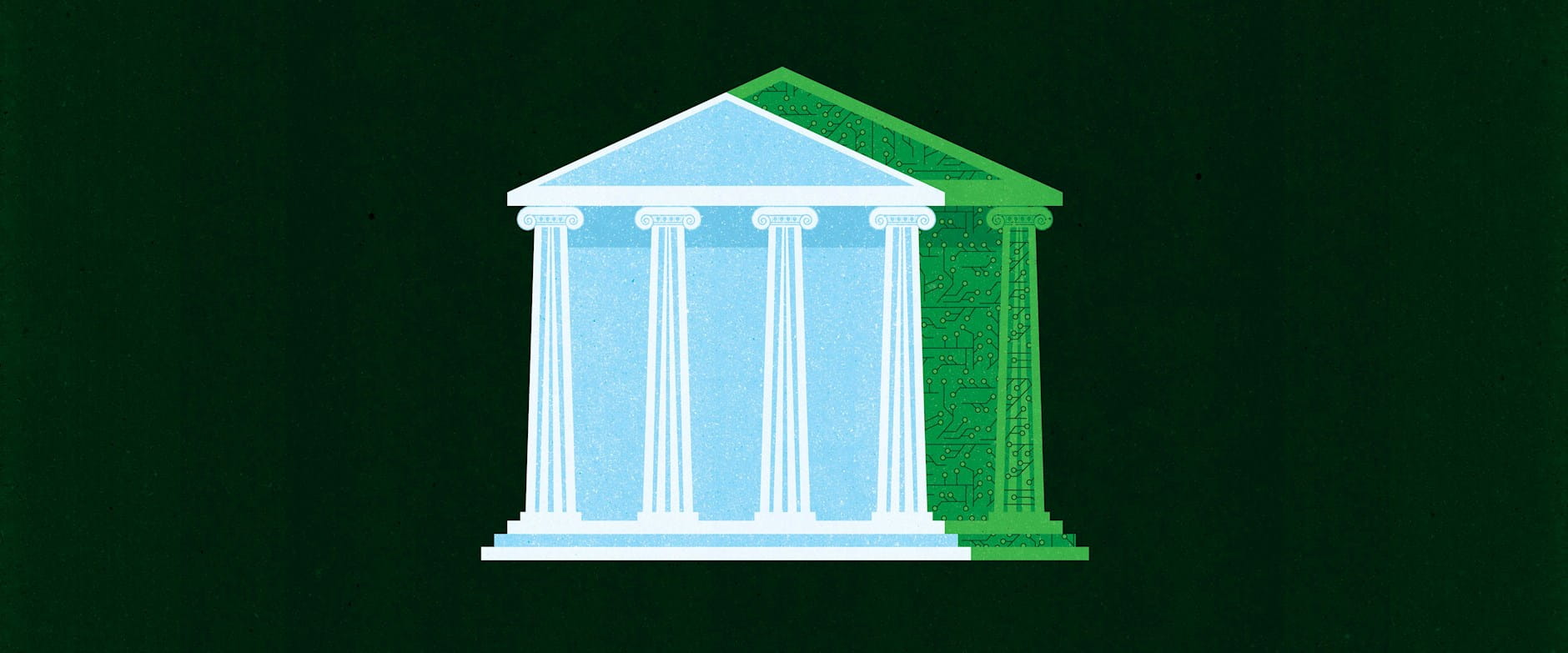Information technology has become the lifeblood of global credit markets. After investing in cutting-edge IT for decades, many commercial banks now look more like tech companies than financial institutions.
But which banks have invested more in tech, and what exactly they’ve invested in, has big implications for the financial system, and for consumers and businesses around the world, according to Chicago Booth’s Zhiguo He, University of Florida’s Sheila Jiang and Douglas Xu (both graduates of Booth’s PhD Program), and University of California at Berkeley PhD student Xiao Yin.
In 2012, IT outlays accounted for an average of between 4.7 percent and 9.4 percent of banks’ operating income worldwide, according to a McKinsey report cited by the researchers. But in 2021, that figure stood at 17 percent for the biggest banks, on par with tech behemoths Apple (12 percent) and Google parent Alphabet (20 percent), per J.P. Morgan analysts.
How exactly are banks directing those outlays? To better understand the spending patterns, He, Jiang, Xu, and Yin focus on two fundamental banking activities: gathering and distributing data, and processing data. For the former, communication technology such as networking hardware enables smooth interactions with borrowers. For the latter, software such as Microsoft Office as well as more specialized tools facilitate fund transfers, loan processing, and risk management.
Big spenders
Growth in IT spending varied across banks of different sizes, with large banks—those with $10–$250 billion in assets—steadily increasing their investments in IT since 2010.
He et al., 2021
The analysis demonstrates a strong correlation between IT spending and banks’ underwriting decisions. This finding stood to reason, the researchers hypothesize, because serving different customers naturally requires different information capabilities.
For example, assessing the creditworthiness of small businesses with shorter track records might require gathering more “soft data” through face-to-face interactions with entrepreneurs. Refinancing home mortgages, by contrast, might demand more horsepower to crunch “hard data” such as credit scores. “As a consequence,” He, Jiang, Xu, and Yin write, “if banks specialize in different types of loan making, one should expect them to differ in their IT investment profiles.”
To explore these links in the United States, the researchers tapped a database—from marketing-services company Harte Hanks—that tracks technology adoption. They gathered details on more than 3 million IT purchases between 2010 and 2019 by 1,800 US commercial banks, or about 80 percent of the US banking sector. Loan data came from various federal sources, including Federal Financial Institutions Examination Council call reports, as well as data disclosed by banks following the Community Reinvestment Act and the Home Mortgage Disclosure Act.
Banks specializing in commercial and industrial loans—especially small-business loans—shelled out more for communication hardware than software, the researchers find. “If a bank is spending a lot on communication technology, that might be a good indicator as to whether it is committed to serving small businesses,” Jiang says. On the other hand, more underwriting of personal loans and mortgages correlated with larger investments in software, the researchers observe.
Different priorities
Smaller banks allocated a higher share of their IT budget towards communication technology, while software spending was not significantly different across bank sizes.
He et al., 2021
They studied changes in demand for small-business credit spurred by a provision in the Affordable Care Act that began offering tax credits starting in 2014 to small employers that pay for employees’ health insurance. Sure enough, banks located in counties that contained more small businesses eligible for the tax credit spent 26 percent more on communication-related IT than did banks in counties with fewer small businesses. Software-related spending, by comparison, barely budged.
Likewise, the data show that in the aftermath of the 2008 housing crisis, banks spent more on software than communication IT—presumably so they could crank out more credit calculations as interest rates plunged and homeowners scrambled to refinance mortgages.
Finally, the researchers investigated the connection between technology investment and bank payrolls. They examined whether banks’ access to skilled labor—approximated by the number of local land-grant colleges—affected their technology spending. When skilled labor was relatively scarce, the researchers find, the cost of attracting IT talent rose, inducing banks to spend more on software than on communication hardware.
“Our study takes the first step toward understanding the basic pattern of these banking IT expenditures,” the researchers write, “and explores the connections and underlying mechanisms between these expenditures and the core functioning of the banking system.”
Zhiguo He, Sheila Jiang, Douglas Xu, and Xiao Yin, “Investing in Lending Technology: IT Spending in Banking,” Working paper, October 2021.
Your Privacy
We want to demonstrate our commitment to your privacy. Please review Chicago Booth's privacy notice, which provides information explaining how and why we collect particular information when you visit our website.
